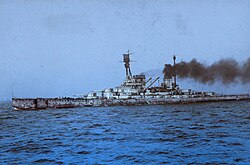Derfflinger class
|
The "SMS Hindenburg"
|
||||||||||||||||
|
||||||||||||||||
|
||||||||||||||||
|
||||||||||||||||
|
||||||||||||||||
The Derfflinger- class was a class of three battlecruisers (officially known as the Große Kreuzer ), the last to be put into service by the German Imperial Navy . The ships were named after German military leaders and followed the single ship Seydlitz . The type ship Derfflinger was named after the Brandenburg General Field Marshal Georg von Derfflinger .
draft
While the previous Seydlitz was an evolutionary further development of the older battlecruisers of the Imperial Navy, a completely new design had been developed with the Derfflinger class. The class was also the first class of battlecruisers to be built using a smooth-deck construction. All previous ships had a descending number of decks from bow to stern. The Derfflinger was the first capital ship of the imperial navy to have this innovation. This type of construction was made possible because the ship was significantly lengthened compared to its predecessors, giving it a long forecastle , which offered better protection for the guns against ingress of water. In the lower part of the fuselage there was a new type of longitudinal frame system that had already proven itself on small cruisers . The bow was also redesigned and was designed to be completely vertical above the waterline. The ships of the class were elegantly designed and were considered the most beautiful capital ships in the Imperial Navy.
In the course of the war, the narrow tubular mast was removed and replaced by a three-legged mast, like the one on the newest German capital ships of the Bavaria class , in order to accommodate an artillery control post and an observation post.
The battles on the Dogger Bank (January 1915) and in the Skagerrak (May 31 - June 1, 1916) demonstrated the stability of the Derfflinger class and at the same time showed the British disparity between armor on the one hand and main artillery and machinery on the other on. The Derfflinger was severely damaged in both battles, but was able to march back on its own and was fully operational again after a short shipyard overhaul. Later evaluations came to the conclusion that the Derfflinger was on a par, if not superior, to its British counterparts. The advantageous relationship between armor, speed and main armament could not be affected by some weaknesses, such as the lower speed and the lower projectile weight of a broadside compared to British ships of the same age.
A serious shortcoming of the Derfflinger class, however, was the torpedo room in the bow, which was the undoing of the sister ship Lützow in the Battle of the Skagerrak.
All three units showed slight constructional differences, especially the Hindenburg , which was somewhat larger and equipped with a significantly more powerful machine system than the Derfflinger .
Armament
The main armament consisted of eight 30.5 cm rapid-loading guns in four twin turrets, two each in an overfiring configuration in the bow and stern of the ships. These were designated from front to aft as “A” to “D” towers or, based on the radio alphabet, “Anna”, “Berta”, “Caesar” and “Dora” towers. The tower's distance measuring devices of the Hindenburg had not, but front mounted a broader basis and were up on the side of the four double towers.
The middle artillery consisted of twelve ( Derfflinger ) to fourteen ( Lützow and Hindenburg ) 15 cm guns in individual casemates at the level of the battery deck.
Furthermore, four torpedo tubes of the caliber 50 cm (at Lützow and Hindenburg 60 cm) were built into the hull below the waterline, one each facing forward, backward and on both sides. After the Battle of the Skagerrak and the loss of the Lützow after a hit in the bow torpedo room, the bow torpedo tube was removed and the associated room was divided.
The ships were also with eight anti-aircraft guns of the caliber equipped 8.8 cm, of which, however, war broke half was given to the equipment of supply vessels.
The main differences in armament to the predecessor ships lay in the increase in the caliber of the main artillery from 28.0 cm to 30.5 cm. This was still below the caliber of comparable British battlecruisers, but the German shells were of better quality and their penetration power was on a par with their British counterparts, as the German guns had a higher muzzle velocity. For weight reasons, however, the number of towers was reduced from five to four.
Another innovation in German capital shipbuilding was the arrangement of the main artillery in the center ship line. The four towers were arranged one behind the other at the bow and the stern so that the inner towers could overshoot the outer ones. The predecessor ships, such as the Moltke class , still had an asymmetrical arrangement in the central nave with laterally offset “wing towers”. The lower towers were now one deck lower than before, which is why the battery deck was raised at the bow and stern to achieve the required freeboard.
drive
As with the liners of this period, there was a mixed coal-oil firing. The cruising speed was slightly increased compared to the Seydlitz .
literature
- Erwin Strohbusch: Warship building since 1848. German Maritime Museum, Bremerhaven 1984.
Web links
Footnotes

